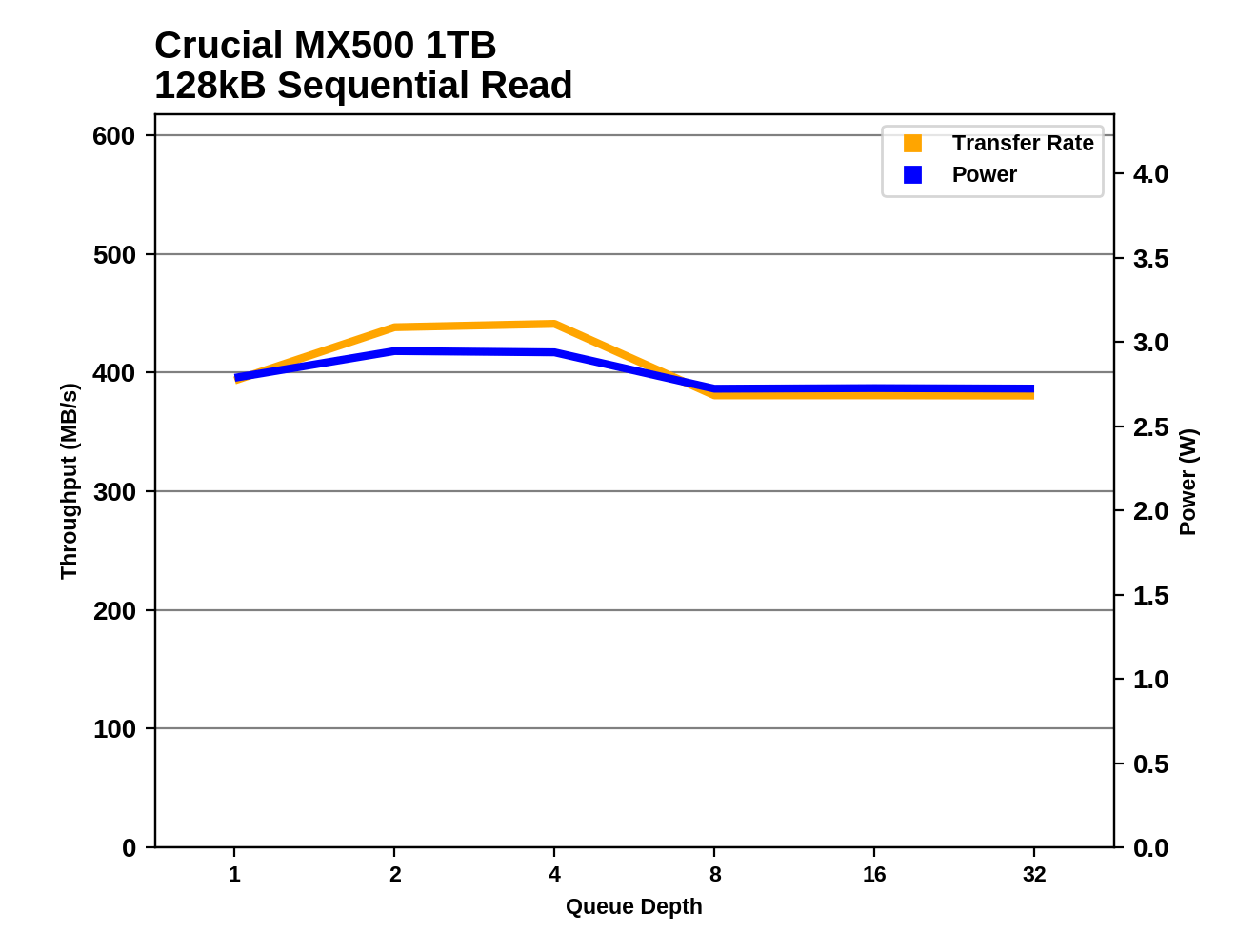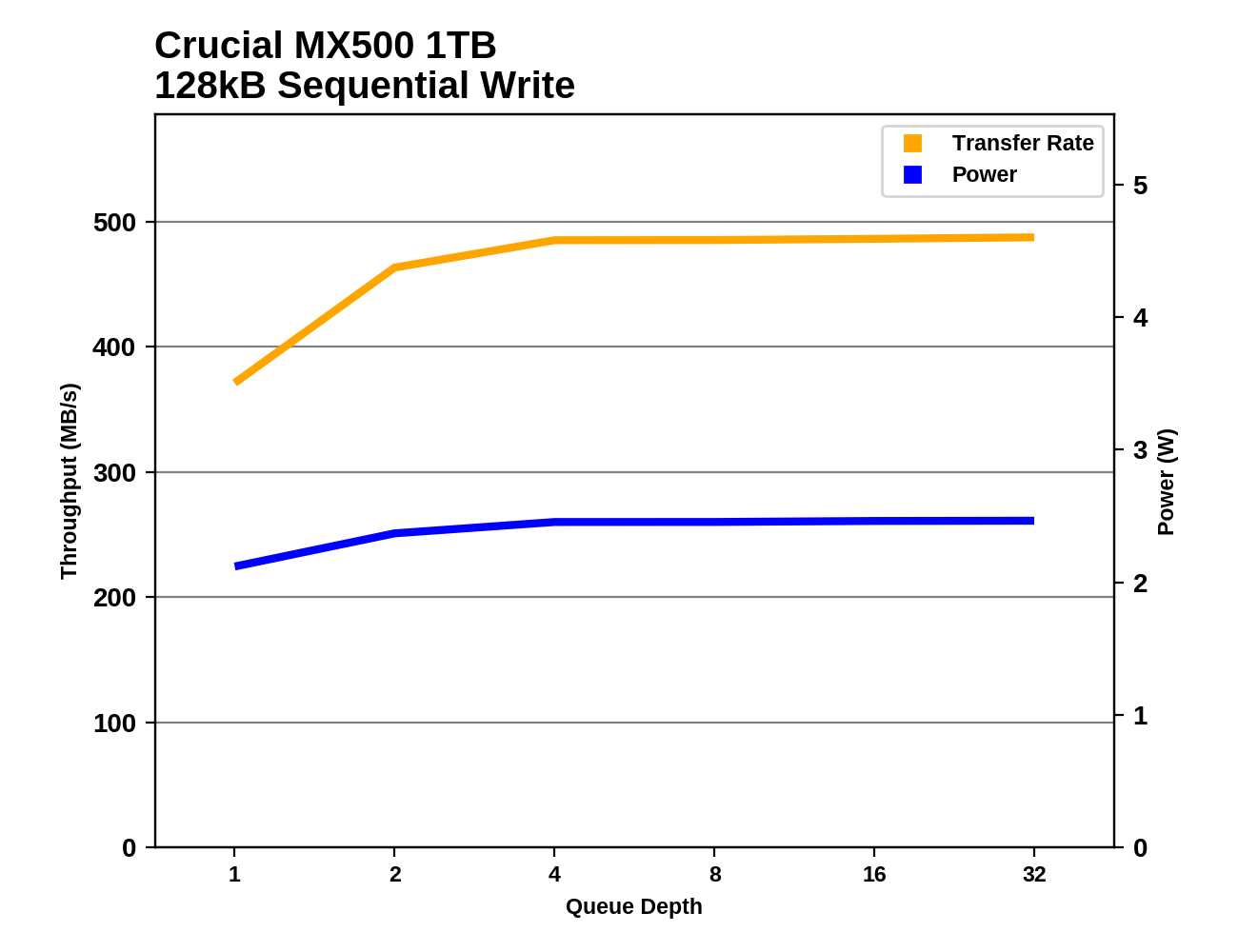The Crucial MX500 1TB SSD Review: Breaking The SATA Mold
by Billy Tallis on December 19, 2017 8:00 AM ESTSequential Read Performance
Our first test of sequential read performance uses short bursts of 128MB, issued as 128kB operations with no queuing. The test averages performance across eight bursts for a total of 1GB of data transferred from a drive containing 16GB of data. Between each burst the drive is given enough idle time to keep the overall duty cycle at 20%.

The Crucial MX500 turns in another record-setting burst performance score with its sequential read results, but by the smallest margin yet. It's about 6% faster on this test than most mainstream SATA SSDs.
Our test of sustained sequential reads uses queue depths from 1 to 32, with the performance and power scores computed as the average of QD1, QD2 and QD4. Each queue depth is tested for up to one minute or 32GB transferred, from a drive containing 64GB of data.

The sustained sequential read performance of the Crucial MX500 puts it in second place, behind the Samsung 850 PRO and 850 EVO. The MX500 does have a slight advantage over the other 64L 3D TLC drives, and improves on the MX300's performance by an impressive 100 MB/s.

The power efficiency of the Crucial MX500 during sequential reads is mediocre and clearly worse than the other 64L 3D TLC drives, including the Intel 545s. The MX500 is slightly more efficient than the Samsung 850 PRO and EVO, and scores 21% higher than the MX300.
 |
|||||||||
The Samsung 850 PRO and EVO are the only drives that continuously saturate the SATA bus from QD2 onwards with no drops in performance. The MX500's performance is reasonably steady but does drop a bit as the test wears on.
Sequential Write Performance
Our test of sequential write burst performance is structured identically to the sequential read burst performance test save for the direction of the data transfer. Each burst writes 128MB as 128kB operations issued at QD1, for a total of 1GB of data written to a drive containing 16GB of data.

For once, the burst performance of the Crucial MX500 doesn't set a record. Its QD1 sequential write speed is only second-fastest, about 3% slower than the Samsung 850 PRO.
Our test of sustained sequential writes is structured identically to our sustained sequential read test, save for the direction of the data transfers. Queue depths range from 1 to 32 and each queue depth is tested for up to one minute or 32GB, followed by up to one minute of idle time for the drive to cool off and perform garbage collection. The test is confined to a 64GB span of the drive.

The sustained sequential write speed of the MX500 is the same as the MX300, putting them in the second tier of performance behind the Samsung 850 PRO and EVO and the MLC-based Patriot Ignite.

The Crucial MX500 scores great on power efficiency during sequential writes, but not quite as well as the MX300. The OCZ VX500 with its reduced DRAM cache holds on to first place and the Toshiba TR200 (entirely DRAMless) comes in right behind the MX500. The mainstream 3D TLC drives are all much less efficient.
 |
|||||||||
Only a few drives offer a higher sustained sequential write speed than the MX500 after reaching saturation. The Samsung drives and the Patriot Ignite are faster at all queue depths and much less pwoer efficient than the MX500, while the OCZ VX500 stumbles at QD2 before saturating with slightly higher throughput and substantially lower power consumption. The MX300 is a bit faster than the MX500 at QD2 but slightly slower at higher queue depths.










90 Comments
View All Comments
Kristian Vättö - Tuesday, December 19, 2017 - link
The BX300 is merely a vehicle to consume low yielding MLC wafers.oRAirwolf - Tuesday, December 19, 2017 - link
Can you expand on that statement? Low yielding in what ways?hojnikb - Tuesday, December 19, 2017 - link
Probably not as good performing (endurance, write performance) dies get used with bx300 instead of discarding them or using them elsewhere.jabber - Tuesday, December 19, 2017 - link
But where else would Crucial be using the good MLC ones if everything else is TLC?cblakely - Tuesday, December 19, 2017 - link
Enterprise productsKristian Vättö - Wednesday, December 20, 2017 - link
Most of it is going to mobile and industrial applications, of which both have very strict quality requirements. The ones that don't meet the criteria can either be sold as wafer/component or used in a retail client SSD, the latter obviously having a better profit margin.Memory is yielded at wafer level. Dies from a low yielding wafer statistically have a higher probability of failure in long-term, even if individual dies are OK in initial probing.
sonny73n - Wednesday, December 20, 2017 - link
WTH are you talking about? Testing endurance and write performance of every die? It's not common sense at all. Therefore, you're a bullshit.FunBunny2 - Wednesday, December 20, 2017 - link
"WTH are you talking about? Testing endurance and write performance of every die? It's not common sense at all. Therefore, you're a bullshit. "that's not what he said. what he said was, post mortem analyses have shown that wafers with a low yield produce dies with short lifespans. those dies are then shipped out as retail SSD.
emvonline - Tuesday, December 19, 2017 - link
Kristian is a wise man. BX300 is a pragmatic response ... not a strategy. MX500 is very well positionedmalventano - Tuesday, December 19, 2017 - link
Low yield MLC wafers would likely not produce usable TLC dies with a higher endurance rating than Samsung's currently shipping V-NAND.